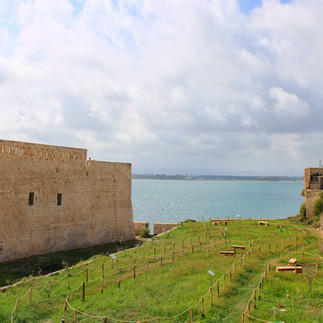Today we are in Sicily. One of the most beloved and iconic places of the island, of course, Ortigia - the historical center of the former ancient Greek colony, which centuries later tells its story through architecture, culture, food and many interesting features of the city Syracuse. You can get to know more in our guide dedicated to a walk around Ortigia. And today, the Ancient Castle – Castello Maniace - deserves our special attention.

By strolling through the streets of Ortigia, you can conveniently explore the main square of Piazza dell Duomo, its Cathedral, the church of Santa Lucia alla Badia, and the square of Archimedes, who lived and worked in this area on the shores of Syracuse. Upon reaching the Arethusa Fountain, you will be able to enjoy a picturesque walk along the stunning promenade, where you can admire the clear turquoise sea and its waves, as well as catch a glimpse of the imposing Maniace Castle at the island's farthest point.

Similar to the castles in Bari, Trani, Barletta, Brindisi, Augusta, and Catania, Castello Maniace stands on the coast, overlooking the sea on one side and the city on the other. Positioned at the far end of Ortigia, at the entrance of Porto Grande, it occupies a highly strategic position where military outposts have been established over the city's extensive history.
The name Castello Maniace originates from George Maniakes, a Byzantine general who briefly seized the city from the Arabs in 1038. He gifted two Hellenistic bronze Battering Rams, which were later displayed at the entrance to the Swabian Castle, mistakenly preserving the leader's name.

The construction of Frederick II's castle took place from 1232 to 1240. The first records of its establishment are letters sent by Frederick on November 17, 1239 to his subordinates involved in the castle's construction. Throughout its history, the fortress has witnessed several significant events, including the signing of a contract for the University of Naples construction and the hosting of the Aragon family in 1288, during which Peter II of Aragon was crowned.

During almost the entire 15th century, the castle served as a prison. In 1448, following a lavish banquet within its walls, Captain Giovanni Ventimiglia executed all the convicts charged with treason. In recognition of this act, King Alfonso of Castile presented him with two bronze Battering Rams that had previously adorned the castle's facade.

The castle was handed over to the Kingdom of Savoy and served as a storage facility for military equipment until the Second World War.

Make sure to include a visit to this fortress in your itinerary to experience the spirit and history of numerous tales, as it has always been the most significant one, capturing the essence of the ancient city!







Comentários